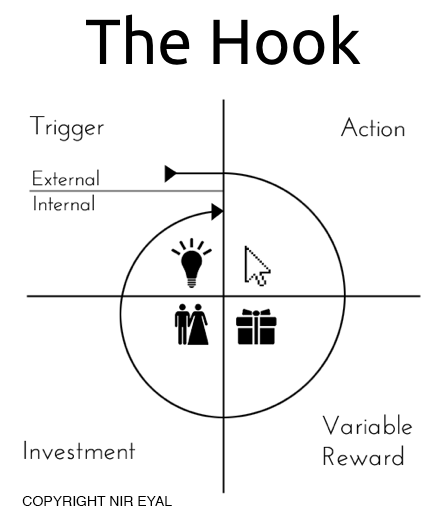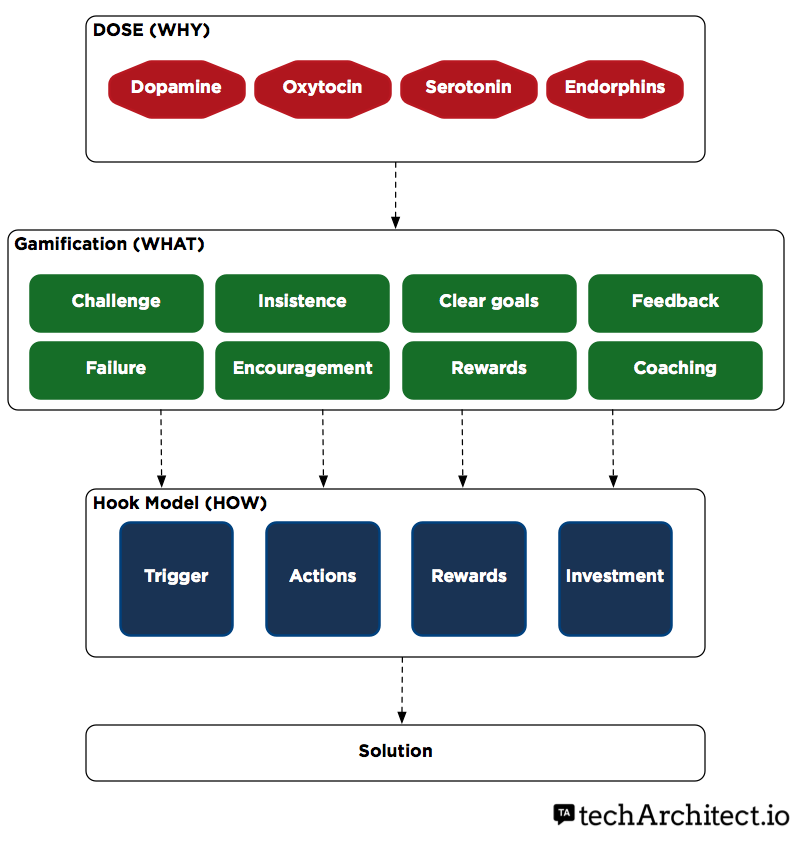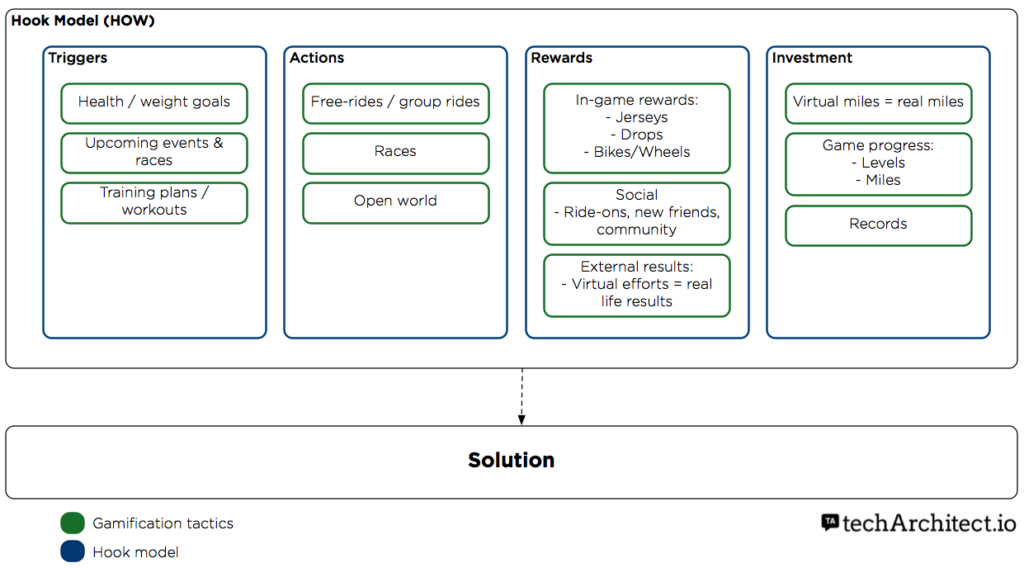Hundreds of articles have been written about Zwift, its success, and how it took the cycling and indoor trainer world by storm. Yet I haven’t seen one that goes a little deeper than just the obvious generalities about how it gamified the indoor trainer experience. That was my main motivation behind writing this post.
Did I have to do anything with its development? Did I put money on it? Do I have any sort of relationship beyond being a user of the product? No to all of those. But as a product minded professional, I felt compelled and take it as a professional duty to dissect Zwift’s success from a Product Strategy & Management perspective.
Disclaimers
- I’m an avid user of the product, maybe not as much as others, but I’m there, riding 3-5 times a week on the platform and combining it with outdoor riding.
- My current level: 42, I own the Tron bike, and completed the Uber Pretzel (one of the longest and possibly hardest route on Zwift) in about 6h. That’s 6 hours on an indoor trainer, which out in the real world would be like 10h, that’s a fact and proven math.
- Strava profile: https://www.strava.com/athletes/14428123 (I’ve got nothing to hide).
What is Zwift?
“Zwift is a turbo trainer game that enables you to link you turbo trainer up your computer, iPad, iPhone or Apple TV, letting you ride with other cyclists in a virtual environment, therefore helping to alleviate some of the boredom associated with indoor riding.”
Cycling Weekly
Most of definitions/descriptions you’ll find on the Internet are similar or variations of that. But it’s wrong. The way I see it, it’s really an MMORPG (Massive Multiplayer Online Role Playing Game), and most of the platforms’s success comes from the fact that they have approached it like such.
Of course, the indoor training + exercise component is key and central, and without it, you have nothing, but how they have strategized the experience is all about gamification and taking advantage of human psychology and neuroscience to create a product that creates habits and makes you want to come back.
Gamification – The Basics
To start, the obvious, Zwift has gamified the indoor training experience with unprecedented levels of success. Gamification, according to Oxford English Dictionary is “the application of typical elements of game playing (e.g. point scoring, competition with others, rules of play) to other areas of activity, typically as an online marketing technique to encourage engagement with a product or service.”
But what’s behind it, really?
Games, specially RPGs and MMORPGs, take advantage and promoted the release of all 4 chemicals typically associated with happiness (DOSE: dopamine, oxytocin, serotonin, endorphin). These chemicals are associated with the following set of emotions, feelings and well-being aspects of life:
- Dopamine – happiness drug, reward system, long term goals
- Oxytocin – social structures, empathy, bonding
- Serotonin – regulator, exercise
- Endorphins – exercise
Zwift and Gamification
Having established that Zwift is a MMORPG, these are the main gamification strategies that play a major role in the platform:
Objectives & Clear Direction
As you’ll see as a recurring trend, Zwift mixes external and internal drivers in a very successful way. In this case, you might already have external objectives and clear directions in the form of weight goal, maybe you are training for a real-world event, or you just want to keep an active lifestyle.
On the other hand, within the platform, you get a sense of goals and directions via upcoming Zwift rides and events, club organized rides, official races, you are following a virtual plan, or just want to do one of the default workouts.
Progress is Visible
You have your own external visible cues such as shedding some weight or improving your time on a local climb. Internally, the platform is full with visual and engaging cues of your progress: your current level, your accumulated miles, you have access to a dashboard with all your activities along with all metrics recorded per activity, etc. And those are just to name a few.
Feeling ‘hooked’ already? Feeling how Zwift is sucking you in?
Rewards
Plentiful rewards abound within the virtual worlds of Watopia, London, Richmond, Innsbruck and the rest.
- New jerseys / kits for reaching new levels, completing a challenge or participating on an event.
- New levels also bring you more than jersey, you get cool glasses, new shoes, new bikes.
- Drops – it’s the game’s currency, you basically can exchange drops (as in sweat drops) for new wheels and bikes.
- Social rewards – you get ‘ride ons’, likes, high-fives and the sense of community.
This all might sound crazy to you, the virtual jerseys, the kits, the glasses, etc. But that’s the key of MMORPGs. You basically have an avatar on the virtual world that represents who you are, and you can change everything that is relevant to a cyclist: the kit, the wheels, the bike, the helmet, the color of your socks, etc. Not my proudest moment, but I have to recognize that sometimes I spend a few minutes before a virtual ride deciding which kit to use. It’s all about motivation and how you feel that day, just like a real world ride.
And externally, you of course get the reward of getting fitter, faster, healthier, etc. Exercise is one of those keystone habits that will make you initiate other good habits, like eating well, prioritizing sleep, etc. What’s not to love?
Variety and Novelty
A successful game keeps the experience novel. On Zwift you get that with a plethora of worlds: Watopia, Innsbruck, Richmond, London, France, Yorkshire and New York – and they keep adding new worlds every year. Within each world you have plentiful of different rides, but at the same time, it’s an open world. You don’t have to follow a pre-established route, you can make your own route, you can make a left instead of a right, you can make u-turns, etc.
In the real-world, I like to do hill repeats as part of my training regime. When I do that on Zwift, I literally do that too, I go up, make a u-turn, go down, repeat.
Constant Challenge
If everything was easy, or if once you achieve a certain level everything becomes easy, you will not be challenged, and you will quit the game, any game. Successful gamification requires that challenges within the game grow at the same rate you improve your level.
Zwift keeps your personal records for specific segments, so you are always challenging yourself to improve those times. If you like racing, you will also be placed on different racing categories depending on your previous performances. So, once you go from level C to B, you can’t stay on group C to overpower your fellow level-C cyclists. That’s called ‘sandbagging’, it’s frown upon, and you will actually get disqualified from the race.
The Hook Framework – The Basics
From Alex Cowan’s Product Management Site – “The Hook Framework connects your solution to the user’s problem with enough frequency to form a habit. The Hook framework has four components: Trigger, Action, Variable Reward, and Investment”.
At its simplest form, the hook model describes how businesses can fundamentally change behavior within their users, and create day-to-day habits around their products. The heart of the principle is that businesses should always seek to connect a user’s problem to your solution with enough frequency to make it a habit.
Nir Eyal is the mastermind behind this framework/model, and he explains everything in his book Hooked: How to build habit-forming products.

Zwift and Hook
This is where I tie everything: the neuroscience, gamification, the hook model, and how it results in Zwift. Results in present tense, as the platform is continuously evolving and adding features and capabilities on almost a weekly basis.
To me, I layer those concepts as follows:
- The DOSE and neuroscience are the ‘why’ – Why do we like and enjoy products, why do we enjoy some habits over other type of activities.
- Gamification is the ‘what’ – what tactics can we apply that take advantage of the science behind DOSE? What are proven user interactions that leverage that?
- Hook model is the ‘how’ – how you take those concepts and tactics and organize them in a way that results in a habit-forming product: trigger, action, variable rewards and investment.
The general layering of these concepts look like this:

And specifically for Zwift, it will translate to this:

Hook Investment
A final word on this particular aspect of Hook, since I believe it’s one of the biggest differentiators of the platform – Investment.
Virtual Miles = Real Miles
I summarize it as “virtual miles = real miles”. And that translates many implications or observations:
We are not talking about a Guitar Hero to real guitar analogy (no disrespect to Guitar Hero warriors out there). The physical, health and performance improvements you gain in the game, does translate to real world gains. Sure, riding the bike in the real world is way more than just pushing the pedals, it involves skills like drafting, navigating through traffic, cornering, downhill and breaking, etc. But from a health and endurance point of view, virtual miles are in fact real miles.
Power is power – is another phrase you’ll hear in the Zwift forums and channels, and it encapsulates part of the same concept.
The physics engine is superb. All things considered, and you putting in your real height and weight, the efforts you put in the virtual world are very similar to the real world. A 6% gradient hill feels the same both in game and in the real world. Or to be more precise – for a given climb gradient, and you pushing at a specific power (watts), you’ll get to the top in the same time it would take you in the real world for that same climb profile (trying to avoid ‘trainer difficulty setting’ enthusiasts).
That, in combination with the advances in both indoor trainer technology as well as power meters, it is a pretty neat combo. Not a replacement for the real world experience if you ask me, nor exactly the same in terms of efforts, etc., but pretty close.
This translates into feeling that the investment you have with Zwift is a real investment, not something that will stay within the walls of a virtual world. We cyclists track miles and elevation gains, we set yearly goals for those. To me, the miles and feet I have gained in Zwift are no less than the ones I have gained in the real world. Those virtual drops cost the same effort and the same time.
Conclusions
The result of this observation is that Zwift is full of such a diverse set of users that it’s amazing:
- Virtual warriors
- Weekend warriors
- Real pro cyclists
- Amateur cyclists
- Old or young
- Recovering from an injury
- Winter / night training without the safety issues
It has become the great equalizer for cyclists (and runners) around the world.
Resources
- https://www.cyclingweekly.com/news/product-news/zwift-turbo-trainer-game-171798
- https://www.alexandercowan.com/the-hook-framework/
- https://medium.com/@svharivinod/making-your-product-a-habit-the-hook-framework-7815f94a2ddf
- https://www.amazon.com/Hooked-How-Build-Habit-Forming-Products/dp/0241184835
- Turning your life into a game – https://www.youtube.com/watch?v=s6tLGo9yij0
- The Hook Framework – https://www.alexandercowan.com/the-hook-framework/
- https://www.bicycling.com/training/a30245591/how-zwift-is-turning-indoor-training-skeptics-into-believers/